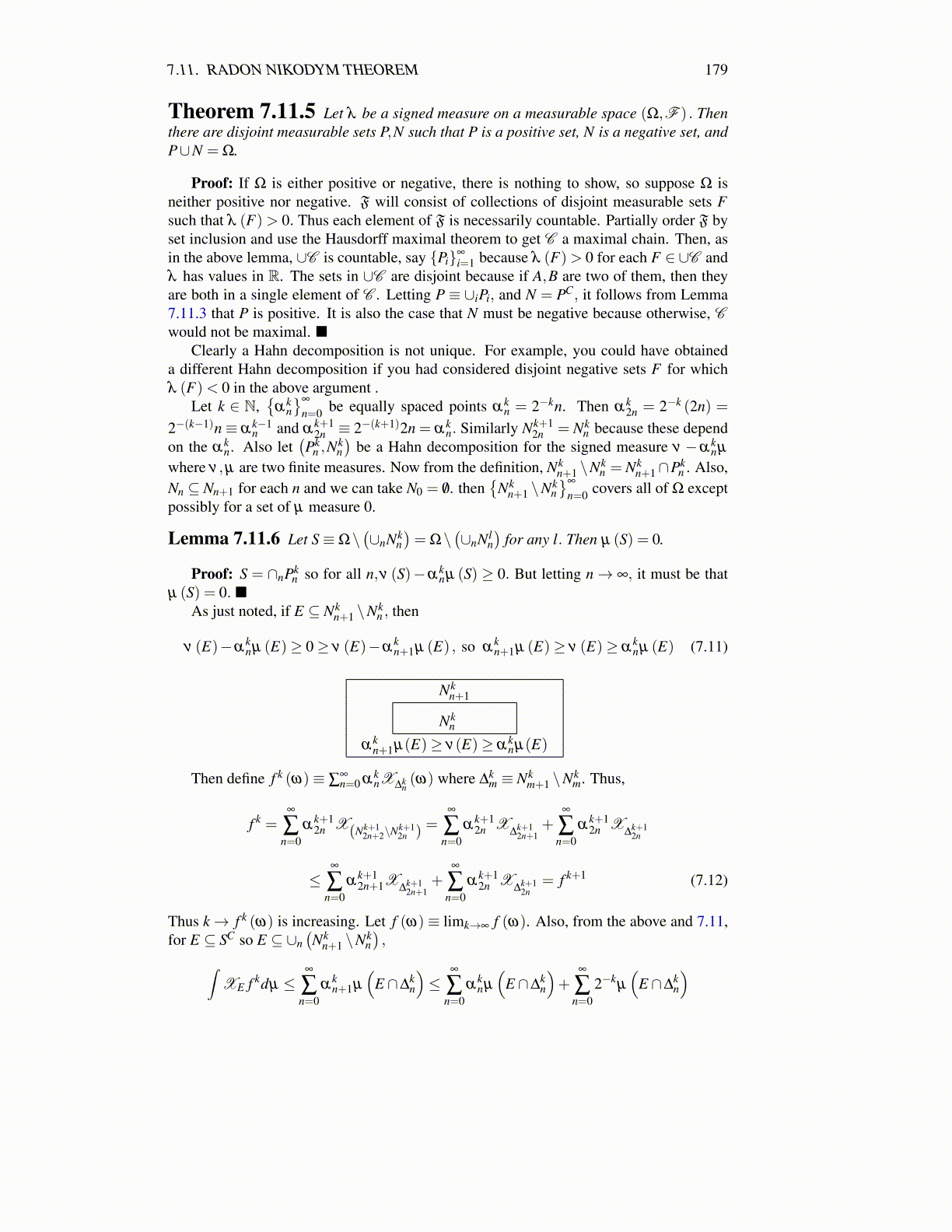
7.11. RADON NIKODYM THEOREM 179
Theorem 7.11.5 Let λ be a signed measure on a measurable space (Ω,F ) . Thenthere are disjoint measurable sets P,N such that P is a positive set, N is a negative set, andP∪N = Ω.
Proof: If Ω is either positive or negative, there is nothing to show, so suppose Ω isneither positive nor negative. F will consist of collections of disjoint measurable sets Fsuch that λ (F)> 0. Thus each element of F is necessarily countable. Partially order F byset inclusion and use the Hausdorff maximal theorem to get C a maximal chain. Then, asin the above lemma, ∪C is countable, say {Pi}∞
i=1 because λ (F)> 0 for each F ∈ ∪C andλ has values in R. The sets in ∪C are disjoint because if A,B are two of them, then theyare both in a single element of C . Letting P ≡ ∪iPi, and N = PC, it follows from Lemma7.11.3 that P is positive. It is also the case that N must be negative because otherwise, Cwould not be maximal. ■
Clearly a Hahn decomposition is not unique. For example, you could have obtaineda different Hahn decomposition if you had considered disjoint negative sets F for whichλ (F)< 0 in the above argument .
Let k ∈ N,{
αkn}∞
n=0 be equally spaced points αkn = 2−kn. Then αk
2n = 2−k (2n) =2−(k−1)n≡ αk−1
n and αk+12n ≡ 2−(k+1)2n = αk
n. Similarly Nk+12n = Nk
n because these dependon the αk
n. Also let(Pk
n ,Nkn)
be a Hahn decomposition for the signed measure ν −αknµ
where ν ,µ are two finite measures. Now from the definition, Nkn+1 \Nk
n = Nkn+1∩Pk
n . Also,Nn ⊆ Nn+1 for each n and we can take N0 = /0. then
{Nk
n+1 \Nkn}∞
n=0 covers all of Ω exceptpossibly for a set of µ measure 0.
Lemma 7.11.6 Let S≡Ω\(∪nNk
n)= Ω\
(∪nNl
n)
for any l. Then µ (S) = 0.
Proof: S = ∩nPkn so for all n,ν (S)−αk
nµ (S) ≥ 0. But letting n→ ∞, it must be thatµ (S) = 0. ■
As just noted, if E ⊆ Nkn+1 \Nk
n , then
ν (E)−αknµ (E)≥ 0≥ ν (E)−α
kn+1µ (E) , so α
kn+1µ (E)≥ ν (E)≥ α
knµ (E) (7.11)
Nkn
Nkn+1
αkn+1µ(E)≥ ν(E)≥ αk
nµ(E)
Then define f k (ω)≡ ∑∞n=0 αk
nX∆kn(ω) where ∆k
m ≡ Nkm+1 \Nk
m. Thus,
f k =∞
∑n=0
αk+12n X(Nk+1
2n+2\Nk+12n ) =
∞
∑n=0
αk+12n X
∆k+12n+1
+∞
∑n=0
αk+12n X
∆k+12n
≤∞
∑n=0
αk+12n+1X∆
k+12n+1
+∞
∑n=0
αk+12n X
∆k+12n
= f k+1 (7.12)
Thus k→ f k (ω) is increasing. Let f (ω)≡ limk→∞ f (ω). Also, from the above and 7.11,for E ⊆ SC so E ⊆ ∪n
(Nk
n+1 \Nkn),∫
XE f kdµ ≤∞
∑n=0
αkn+1µ
(E ∩∆
kn
)≤
∞
∑n=0
αknµ
(E ∩∆
kn
)+
∞
∑n=0
2−kµ
(E ∩∆
kn
)